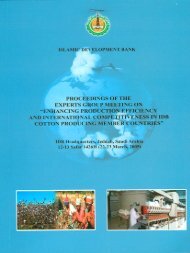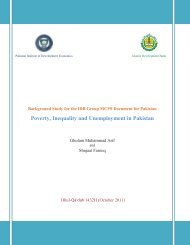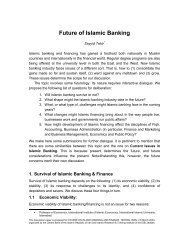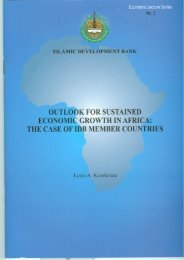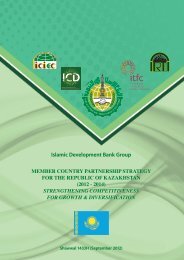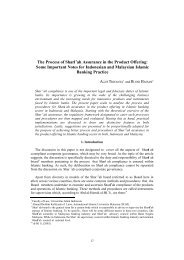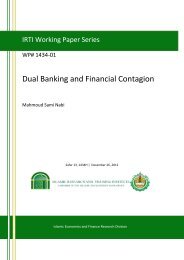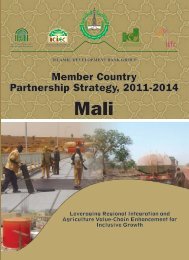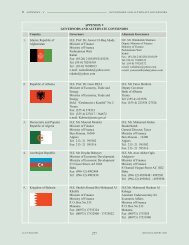Country Economic Work for Malaysia - Islamic Development Bank
Country Economic Work for Malaysia - Islamic Development Bank
Country Economic Work for Malaysia - Islamic Development Bank
Create successful ePaper yourself
Turn your PDF publications into a flip-book with our unique Google optimized e-Paper software.
the Department of Statistics, <strong>Malaysia</strong> (May 2012), domestic demand contributed the largest<br />
share, accounting <strong>for</strong> 10.7 percentage points of total GDP growth in 2010 while the growth was<br />
contracted by 3.5 percentage points due to decline in external demand. Among domestic demand<br />
factors, private consumption contributed 3.5% and private investment 1.8% and will likely be the<br />
key growth drivers in 2011 and 2012, with rural areas benefitting from elevated commodity<br />
prices and urban areas from continued growth in the manufacturing and services sectors (Table<br />
1.1). Leading indicators such as rubber prices, stock market index, consumer sentiment index, and<br />
number of retrenched workers suggest that consumer spending will remain buoyant in the coming<br />
years. Solid employment and modest wage increase in line with improving external demand as<br />
well as buoyant commodity prices are also expected to support household income and<br />
consumption. Similarly, private investment is likely to rise with the implementation of projects<br />
under the Government’s <strong>Economic</strong> Trans<strong>for</strong>mation Program (ETP), which is being largely driven<br />
by the private sector.<br />
7. In terms of sectoral<br />
per<strong>for</strong>mance, services sector<br />
remained the main source of<br />
economic growth. During 2000s,<br />
annual average growth in the services<br />
sector was 6.2%, attributed mainly<br />
due to strong per<strong>for</strong>mance in the<br />
finance, insurance, real estate and<br />
business services, wholesale and<br />
retail trade, hotel industry, and<br />
transport and communication (Figure<br />
1.2). The share of services sector in<br />
GDP also increased from 49.3% in<br />
2000 to 57.7% in 2010 (Figures 1.3<br />
and 1.4). Currently, 87% of the<br />
15<br />
10<br />
5<br />
0<br />
-5<br />
-10<br />
Figure 1.2. <strong>Malaysia</strong>: Sectoral Growth<br />
Rates, 2001-2010 (% per annum)<br />
2001 2002 2003 2004 2005 2006 2007 2008 2009 2010<br />
Agriculture Manufacturing Services<br />
Source: <strong>Economic</strong> Planning Unit, The <strong>Malaysia</strong>n Economy in Figures (various Issues)<br />
Figure 1.3 Sectoral Shares in Gross Domestic<br />
Product of <strong>Malaysia</strong>, 2000 (% of total GDP)<br />
Figure 1.4. Sectoral Shares in Gross Domestic<br />
Product of <strong>Malaysia</strong>, 2010 (% of total GDP)<br />
Agriculture<br />
8.6% Mining<br />
10.6%<br />
Agriculture<br />
7.3% Mining<br />
7%<br />
Services<br />
49.3%<br />
Manufactrin<br />
g 27.6%<br />
Construction<br />
3.9%<br />
Manufactrin<br />
g 30.9%<br />
Services<br />
57.7%<br />
Construction<br />
3.3%<br />
Source: <strong>Economic</strong> Planning Unit, The <strong>Malaysia</strong>n Economy in Figures (2011)<br />
7







